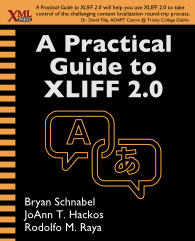
A Practical Guide to XLIFF 2.0
by Bryan Schnabel, JoAnn T. Hackos, and Rodolfo M. Raya
$35.95 (print), $24.95 (ebook).
A Practical Guide to XLIFF 2.0 introduces the OASIS XLIFF standard. Companies use XLIFF to standardize the exchange of source and localized content with localization and translation vendors.
You will learn how to get the most from the XLIFF standard, use best practices in your translation workflow, extend XLIFF, and use the XLIFF modules.
This book is for localization coordinators, technical writers, content management system vendors, localization service providers, and consultants who want to incorporate XLIFF into their customers’ publishing workflow.
Inside the Book
Getting Started: introduces XLIFF, the translation process, and the major parts of XLIFF, including the core and modules.
Applied XLIFF: describes how XLIFF supports translation of XML (including DITA), websites, office documents, graphics, and software user interfaces.
XLIFF Core: introduces the XLIFF core features, including:
- Preserving document structure
- Marking up text for translation
- Segmentation and sub-flows
- Fragment identification
- Extensibility
XLIFF Modules: introduces the XLIFF modules, including:
- Translation Candidates
- Glossary
- Format Style
- Metadata
- Resource Data
- Change Tracking
- Size and Length Restriction
- Validation
XLIFF 2.0 Structure: describes the XLIFF 2.0 schemas, including the core structural and inline elements and module schemas.
Examples: detailed examples, including XSL code, for transforming XML source files into and out of XLIFF.
About the Authors
Bryan Schnabel
Bryan Schnabel is chair of the OASIS XLIFF Technical Committee. He has written software programs for XLIFF and DITA.
JoAnn T. Hackos
JoAnn T. Hackos is retired as president of Comtech Services, Inc. She was one of the founders of the DITA standard. She continues to develop standards for information development through the International Standards Organization (ISO), representing the SC7 Working Group 2.
Rodolfo M. Raya
Rodolfo M. Raya is CTO at Maxprograms, where he develops cross-platform translation/localization and content publishing tools using XML and Java technology.
What are They Saying?
“A Practical Guide to XLIFF 2.0 will help you use XLIFF 2.0 to take control of the challenging content localization round-trip process.”
— Dr. David Filip, ADAPT Centre @ Trinity College Dublin
